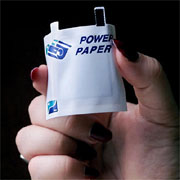May 29, 2003May 30, 2003 - Graphic Solutions, a Burr Ridge, Illinois-based custom print house, has become the first US company to acquire a non-exclusive license from Power Paper to manufacture thin, flexible, environmentally-friendly batteries for the North American market.
Thin-film batteries have the potential to bridge the gap between low-cost passive RFD transponders, which have a limited read range, and more expensive active (battery-powered) tags that can broadcast a signal much further and be read more consistently.
The thin-film batteries developed by Power Paper can be printed on flexible substrates, including paper and labels. Power Paper is currently developing batteries for use in medical and cosmetic patches, novelty items such as greeting cards or toys, as well as active RFID labels (see New Unit for Active Smart Labels).
GSI says that its roll-to-roll manufacturing technology will produce hundreds of millions of semi-active labels in 2004. At the 50 cent to $1.20, these labels will be "affordable enough to justify their use at the case level, pallet level, and even at the item level", says GSI president Suzanne Zaccone. The availability of reusable labels could also make active RFID more economical, she says.
Active RFID tags are used today for longer-range tracking or to ensure a good read when an item is moving. Most toll collection systems, for instance, use active RFID tags. Low-cost active RFID labels could be ideal for tracking pallets of goods moving rapidly through portals or pinch points within a warehouse or distribution center.
GSI and Tel-Aviv, Israel-based Power Paper have partnered to co-develop Power Paper’s PowerID System for active RFID labels. The two companies are modifying a UHF microchip so that it can use power from the thin-film battery, minimize signal collision and increase data transfer rates. GSI says its labels are being designed around industry standard RFID readers, so companies would be able to switch from passive to active systems. The company declined to specify which standard the readers conform to.
GSI expects to have prototype 900 MHz semi-active labels, which draw their power from the reader but use the battery to power the chip, by the end of this year. Zaccone says many companies would be willing to pay a little more for active labels, rather than have to change their processes to make it possible to read passive tags. -- By Mary Lee
Only two weeks left until the most important RFID conference of the year. Register today for RFID Journal Live!, Chicago from June 11 to 13.


